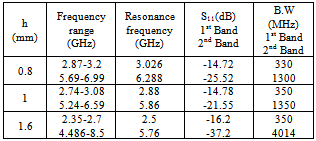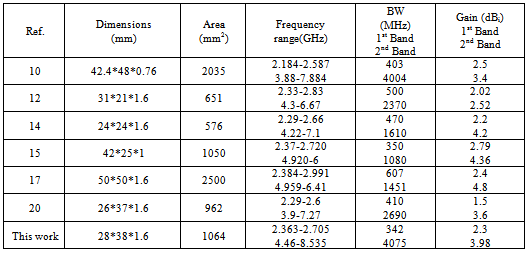-
Paper Information
- Next Paper
- Paper Submission
-
Journal Information
- About This Journal
- Editorial Board
- Current Issue
- Archive
- Author Guidelines
- Contact Us
International Journal of Electromagnetics and Applications
p-ISSN: 2168-5037 e-ISSN: 2168-5045
2013; 3(4): 96-102
doi:10.5923/j.ijea.20130304.05
Design and Analysis of Dual Band Crescent Shape Monopole Antenna for WLAN Applications
K. H. Sayidmarie1, L. S. Yahya2
1College of Electronic Engineering, University of Mosul, Iraq
2Department of Electronic Techniques, Institute of Technology, Mosul, Iraq
Correspondence to: K. H. Sayidmarie, College of Electronic Engineering, University of Mosul, Iraq.
| Email: |  |
Copyright © 2012 Scientific & Academic Publishing. All Rights Reserved.
A dual band crescent shape planar monopole antenna for wireless local area network (WLAN) application is proposed. The crescent antenna is evolved from an arc patch antenna. By adjusting the feed line position along the arc, two distinct bandwidths that meet the requirements for the WLAN standards can be obtained. The proposed antenna covers the frequency bands of the IEEE 802.11 a/b/g (2.4-2.48 GHz, 5.15-5.35 GHz, and 5.725-5.825 GHz). The proposed antenna is investigated using CST software package. The reflection coefficient, radiation pattern, gain and efficiency for various design parameters are investigated. Average gains of 2.3dBi and 3.98dBi are achieved in the lower and higher frequency band, respectively.
Keywords: Crescent Shape Monopole Antenna, Dual Band Antenna, Wireless Local Area Network WLAN
Cite this paper: K. H. Sayidmarie, L. S. Yahya, Design and Analysis of Dual Band Crescent Shape Monopole Antenna for WLAN Applications, International Journal of Electromagnetics and Applications, Vol. 3 No. 4, 2013, pp. 96-102. doi: 10.5923/j.ijea.20130304.05.
Article Outline
1. Introduction
- With a growing interest in the field of wireless communication systems and a competitiveness to design devices that provide multiple services, there is a need for miniaturized multipurpose antennas for the modern communication systems[1]. Multi-band antennas should support multi-frequency operations with suitable radiation characteristics for the desired applications[2]. During recent years, there have been rapid developments in the applications of wireless local area network (WLAN). The 2.45GHz, 5.2and 5.8GHz bands are demanded in practical WLAN applications[3]. The demand of WLAN's are increasing numerously worldwide, because they provide high speed connectivity and easy access to networks without wiring[4]. The printed monopole antenna has become very popular in these applications because of its low cost factor and fabrication simplicity. Printed monopole antenna can easily be integrated in communication systems and fabricated on printed circuit boards e.g. fabricated on laptops for WLAN applications[5].Many types of antennas have been designed for the WLAN application in the 2.4GHz (2.4-2.484GHz), 5.2GHz(5.15-5.35GHz) and 5.8GHz(5.725-5.825GHz) operating bands. The fractal geometry was used either to miniaturize the antenna, or to produce multiband radiators. Due to the self-similarity property of fractals there are multiple copies of the geometry in the fractal object and hence the fractal geometry has been utilized for multiband antennas[6-9]. Printed monopole antennas with folded structure or meander line shape have received much attention. Since the radiating elements of the antenna can consist of many strips, different modes would be excited and the antenna could be applied for dual band purposes[10-12]. Among the used antenna configurations, the ring geometry has many favorable advantages. It requires smaller size than the corresponding rectangular patch to resonate at the same frequency. It also offers wide bandwidth and high radiation resistance when it is excited to operate at higher order modes[13]. Several antennas having ring shape, and operating at dual resonance frequencies have been reported in literature[14-17]. Other interesting shapes, that were used for the printed monopole antennas, are; F-shaped, L-shaped, Omega-shaped, Fork–like with a rectangular ring,[18-21]. All these shapes have been deployed for WLAN applications, and showed dual band operation.A crescent-shaped multiband monopole antenna has been presented recently for mobile wireless applications[22]. The antenna uses a patch radiator, microstrip feed line, and defected ground structure. The realized antenna structure showed a relative bandwidth of 51.8% and gain above 1.5dBi over the frequency interval 1.75 to 3.1GHz. The antenna size was optimized to a volume of 57*37.5*0.8mm3[22].In this contribution a dual band planar monopole antenna for WLAN application is proposed. The antenna has the form of sections of two circles, each having a different radius but the same center, thus forming a crescent shape. The resonance frequencies of the two WLAN bands are adjusted by varying the lengths of the two parts of the arc, which are created by the feed line. The results show two distinct operating bands within s11<-10dB limit. These bands are; 342MHz (2.363- 2.705 GHz) and 4.075GHz (4.46-8.5358GHz), which cover all the 2.4/5.2/5.8 GHz WLAN bands. The antenna has a simple planner structure, a volume of 38*28*1.6 mm3, and acceptable gains are obtained over the two operating bands. This paper is organized as follows. The antenna design is presented in section 2. Detailed discussion of the results and the effect of various antenna parameters are shown in section 3. Performance comparison with other published results are given in section 4, followed by the conclusions.
2. Antenna Design
- To satisfy the IEEE802.11 WLAN standards in the 2.4/5.2/5.8GHz operating bands, dual band antennas with simple structure and desirable radiation performance are required. One way to obtain a dual band operation is that, the antenna structure should have two elements with different lengths so that each one of them corresponds to about a quarter of the wavelength at the resonant frequency[10]. For antenna structures like the arc, two distinct bandwidths that meet the requirements for the WLAN standards can be obtained by adjusting the feed line position along the arc. Thus the arc can be considered as divided into two parts, where each part of them corresponds to one of the two bands. The geometry of the proposed antenna is shown in Fig.1. The antenna was simulated assuming a dielectric FR4 substrate of 1.6 mm thickness, εr of 4.3, and dielectric loss tangent of 0.025. The design parameters of the antenna are listed in Table 1.
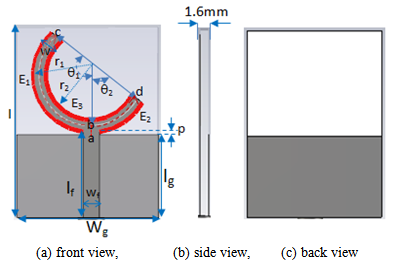 | Figure 1. Geometry of the dual band crescent shape monopole antenna |
|
 | (1) |
 [13], and the approximated value of εeff is given by:
[13], and the approximated value of εeff is given by: | (2) |
 | (3) |
 =1.627. However, k was empirically taken equal to 1.15 as in[23], while the value of k has been considered as
=1.627. However, k was empirically taken equal to 1.15 as in[23], while the value of k has been considered as  as a moderate value[24]. In this work the value of k has been considered as k=1.15, as an empirical value. This value (k=1.15) gives better agreement between simulated and reported values as concluded in[23]. According to Eq.1, the long arc-shaped monopole strip (LL) should have a total length of 26.7mm to excite low band resonance frequency of fr1=2.44GHz. As the long arc-shaped monopole strip (LL) has a total length given by (p+ w/2+average length of long arc), thus the average length of long arc is found to be equal to 24.8mm.The short arc-shaped monopole strip (point a → point b → point d) is used to excite the second resonant frequency (fr2=5.25GHz) band. The length (Ls) of the short arc-shaped strip is calculated from Eq. 4 as:
as a moderate value[24]. In this work the value of k has been considered as k=1.15, as an empirical value. This value (k=1.15) gives better agreement between simulated and reported values as concluded in[23]. According to Eq.1, the long arc-shaped monopole strip (LL) should have a total length of 26.7mm to excite low band resonance frequency of fr1=2.44GHz. As the long arc-shaped monopole strip (LL) has a total length given by (p+ w/2+average length of long arc), thus the average length of long arc is found to be equal to 24.8mm.The short arc-shaped monopole strip (point a → point b → point d) is used to excite the second resonant frequency (fr2=5.25GHz) band. The length (Ls) of the short arc-shaped strip is calculated from Eq. 4 as: | (4) |
3. Results and Discussion
- The proposed antenna was simulated and analyzed using CST Microwave Studio (CST MWS). Figure 2 shows the obtained reflection coefficient response of the antenna with parameters shown in Table 1. It can be seen that the antenna is matched at two resonating frequencies which indicate that the antenna is suitable for WLAN applications. Two resonating modes at 2.5 and 5.77GHz can be clearly observed in the investigated bands. The first band at 2.5GHz has bandwidth of 342MHz (2.363- 2.705 GHz) with reflection coefficient -16dB, which covers the first band of WLAN applications (2.4-2.48GHz). The second band at 5.77GHz has a bandwidth of 4.075GHz (4.46-8.535GHz), with reflection coefficient -37.2dB, covering the second and third bands of WLAN applications (5.15-5.35), (5.725-5.825).
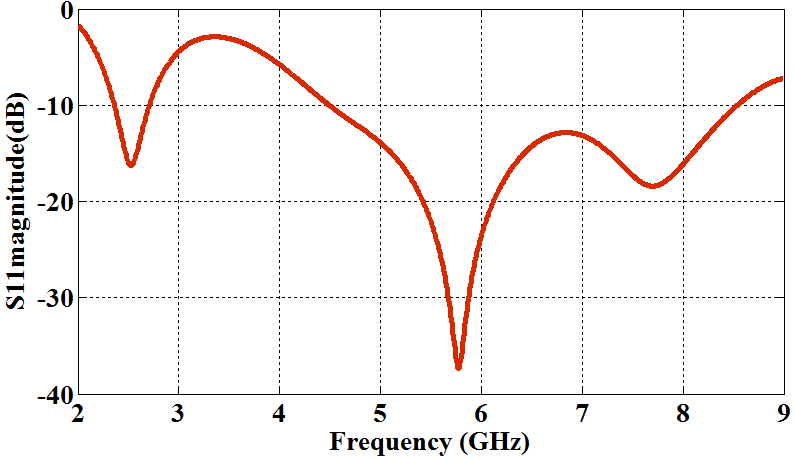 | Figure 2. Reflection coefficient response for the antenna whose dimensions are shown in Table1 |
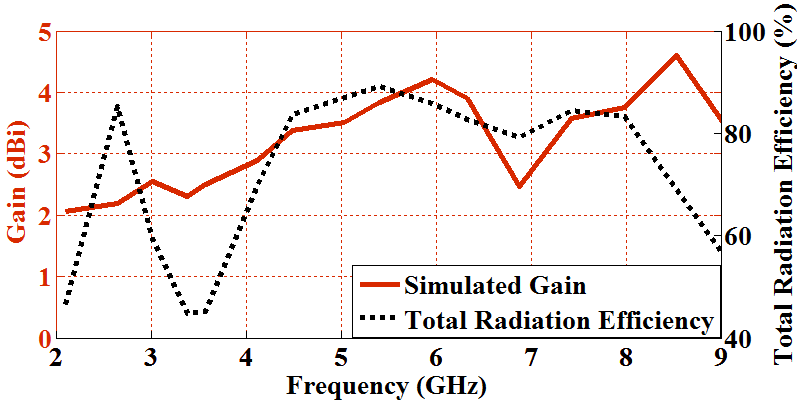 | Figure 3. ariation of simulated gain, and total radiation efficiency with frequency for the dual band crescent monopole antenna, of dimensions shown in Table 1 |
3.1. Effect of Arc Length
- It has been noticed from the simulations, that the resonance frequencies and bandwidths of the proposed antenna depend on the length and width of the arc antenna. Therefore the influences of these parameters are investigated in the following.The crescent shape antenna can be decomposed into two parts; long arc and short arc as shown in Fig. 4. The following investigations consider the effect of varying the length of each part on the obtained results of the part itself as well as the whole crescent antenna.
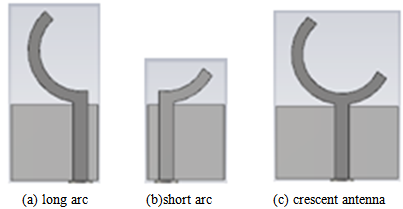 | Figure 4. Decomposition of the crescent antenna (c) into; a long arc (a), and a short arc (b) |
3.1.1. Effect of the Length of Long Arc
- To study the effect of the length of the long arc, some arbitrary values may be considered. However, certain values corresponding to the frequencies, for example, of UMTS (1.920-2.170 GHz) or WIMAX (3.4-3.69 GHz) were considered here to show the design flexibility as well. According to Eq.1, the average length of long arc is equal to 31mm and 16.5mm for these two frequencies respectively. Figure 4.a shows the geometry of the long part of the arc monopole, while Fig. 5 shows the reflection coefficient curve for long arc monopole antenna for three values of its lengths. It can be seen from Fig. 5 that, with increasing the length of long arc from 16.5mm to 31mm, the resonance frequency decreased from 3.4GHz to 2.2GHz. Figure 6 shows the reflection coefficient curves for crescent shape monopole antenna for the above three values of long arc lengths. It can be seen that, with increasing the length of long arc from 16.5mm to 31mm, the reflection coefficient at the first band increases and the bandwidth becomes narrower. This is because the quality factor is inversely proportional to the bandwidth and depends on the reflection coefficient. A lower quality factor means lower reflection back into the "neck"of the monopole antenna towards the source[25]. The resonance frequency decreased as expected. In the higher frequency band, the resonant frequency is decided by the combination of the second resonant frequency due to the short arc and the higher mode of the long arc monopole. Consequently the second frequency band is also slightly affected by varying the length of the longer arc. It can be seen from Fig. 6, that the higher mode of the long arc monopole is shifted up in two cases (long arc=16.5 mm, and 31mm). This leads to increase the bandwidth of the higher frequency band but with less matching.
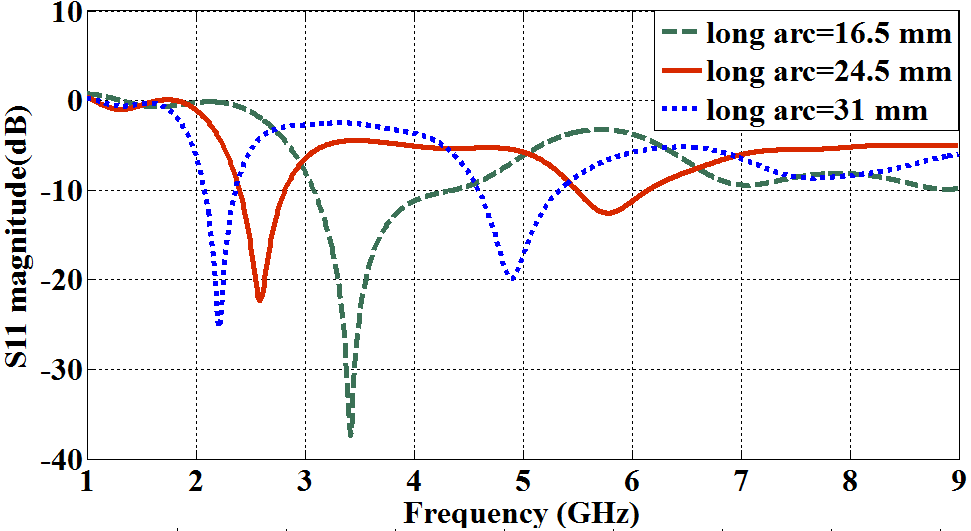 | Figure 5. Reflection coefficient curves for long part of the arc monopole antenna for various values of its length |
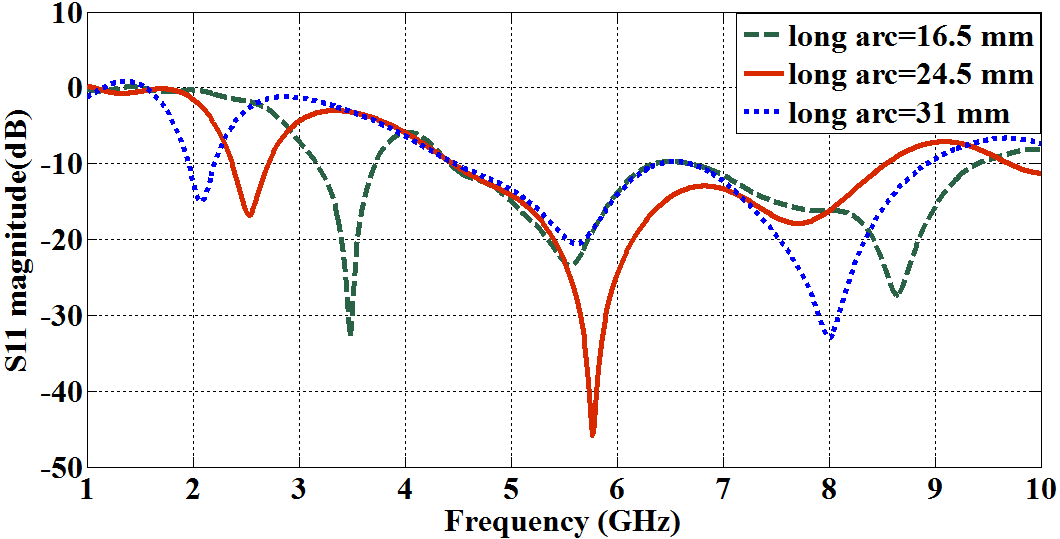 | Figure 6. Reflection coefficients versus frequency for crescent shape monopole antenna for various lengths of long part of the arc |
3.1.2. Effect of the Length of Short Arc
 | Figure 7. Reflection coefficient curves for short arc monopole antenna for various lengths |
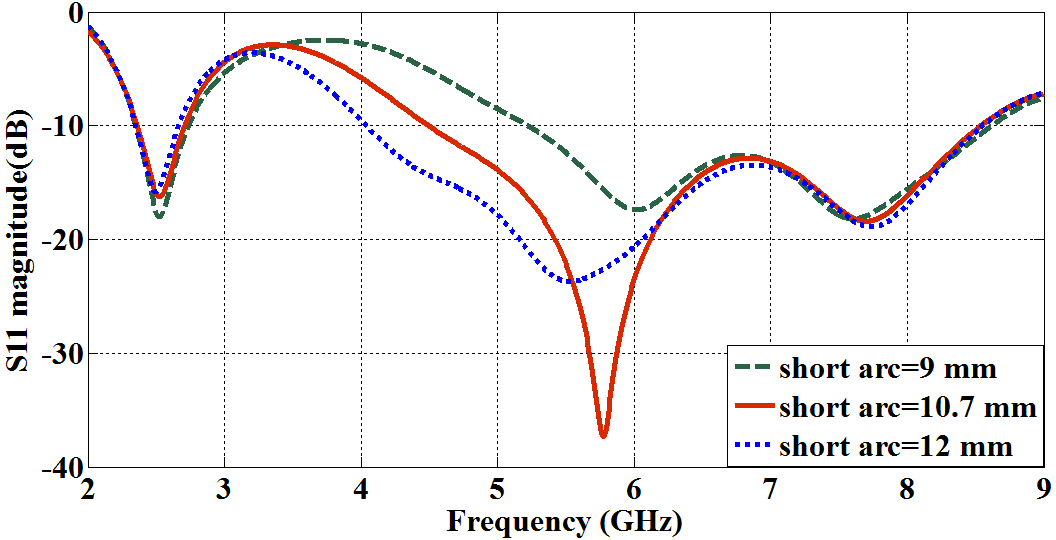 | Figure 8. Reflection coefficient versus frequency for crescent shape monopole antenna for various lengths of short arc |
3.2. Effect of the Arc Width
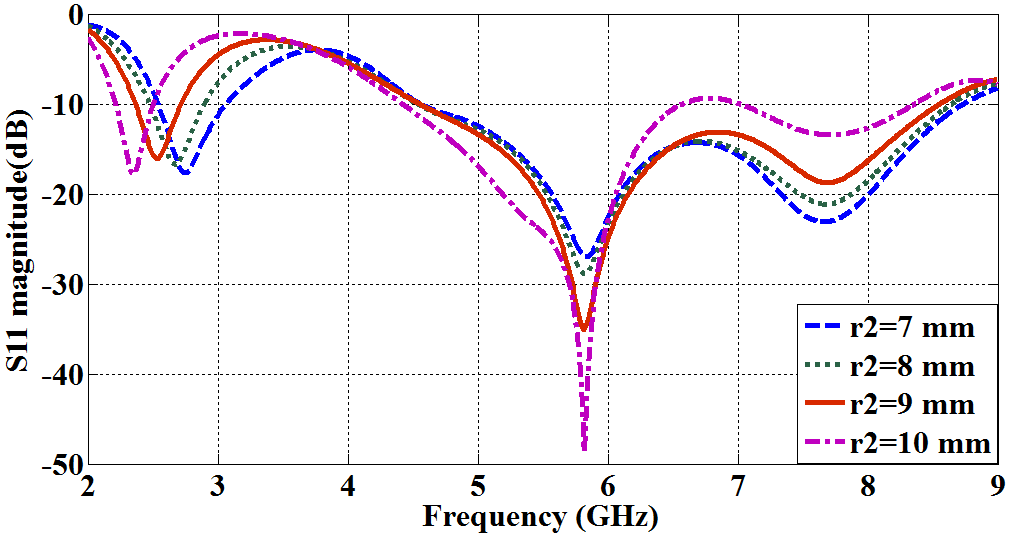 | Figure 9. Reflection coefficient versus frequency for various values of arc width (w=4.5mm, 3.5mm, 2.5mm, 1mm) |
3.3. Effect of the Thickness of Dielectric Substrate
- The proposed antenna, whose dimensions are shown in Table 1, was tested for various substrate thicknesses of 0.8mm, 1mm and 1.6mm. From the obtained results that are shown in Fig. 10 and Table 2, it can be seen that, as the substrate thickness increases, the frequencies of both bands decrease. This is due to the fact that as the substrate thickness increases, more portion of the electric field under the conducting structure fringes out leading to increased effective lengths, which result in lower frequencies. An alternative explanation is that the effective dielectric constant of the substrate increases slightly and produces a decrease in resonance frequency. The bandwidths of both bands show little increase, apart from that of the upper band which exhibited large change for the larger substrate thickness ( h=1.6mm).
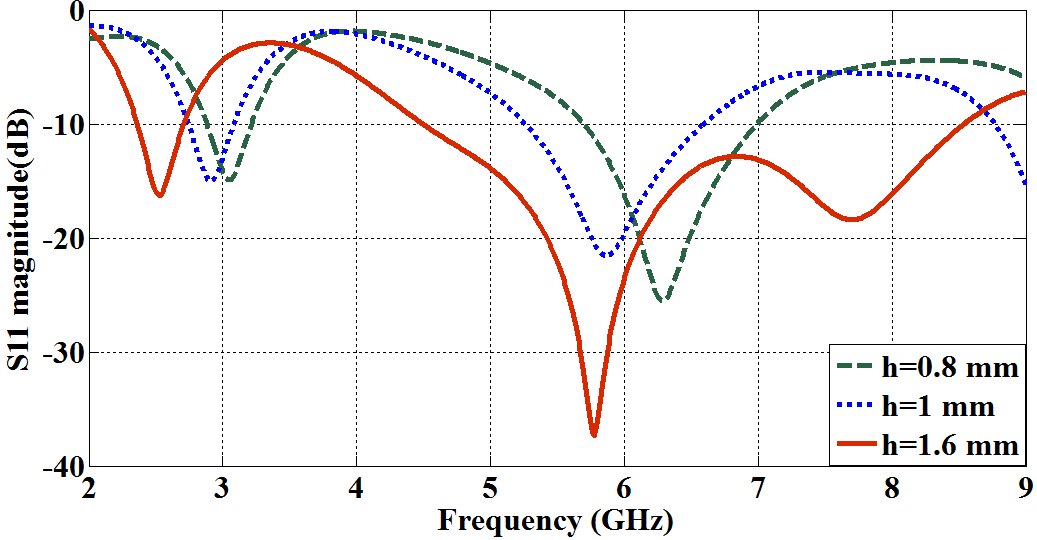 | Figure 10. Reflection coefficient versus frequency for various values of the substrate thickness (h) |
|
3.4. Current Distributions & Radiation Patterns
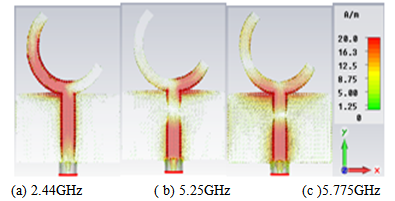 | Figure 11. Surface current distributions of the proposed dual band crescent monopole antenna, at the indicated frequencies |
 | Figure 12. The simulated radiation patterns in the three principal planes for the dual band crescent shape monopole antenna |
4. Comparison of Obtained Results with Those of Published Works
- The performance of the proposed antenna is compared with those of the recently reported WLAN antennas [10,12,14,15,17,20 ], with respect to antenna size, gain and bandwidth as shown in Table 3. It can be seen from Table 3 that the area of the proposed antenna is slightly larger than the antennas reported in[12,14,15,20], but smaller than that for the antennas reported in[10,17]. The bandwidth of the first band is less than that of most of the reported antennas. At the higher frequency band the proposed antenna is providing better bandwidth compared to the other indicated ones. At the lower frequency band, the proposed antenna has higher gain than those reported in[12, 14, 20]. At the higher frequency band, the proposed antenna has higher gain than those reported in[10,12,20]. The proposed antenna is shown to provide a moderate gain compared to existing published antenna structures.
|
5. Conclusions
- The design and analysis of a dual band crescent shape planar monopole antenna for wireless local area network (WLAN) application has been demonstrated. The crescent antenna is evolved from an arc patch antenna. The lower and higher resonant frequencies can be tuned, at will, simply by adjusting the lengths of the two parts of the arc, and/or positioning of the feed line. The antenna showed dual band of operation at 2.4 GHz and 5.2 GHz frequencies and thus can be used for WLAN applications. The designed antenna satisfies VSWR requirement that is less than 2.0 in the two frequency bands (from 2.36 to 2.7 GHz for the first band and from 4.46 to 8.535 GHz for the second band).It has been shown that the antenna operation is influenced by number of parameters; like arc lengths (long arc and short arc), arc width and the thickness of the dielectric substrate. The influence of these parameters on the antenna performance was investigated, and how the change of different antenna parameters impacts the frequency response and bandwidth of the antenna. The antenna has very low return loss and adequate impedance bandwidth at both bands and especially at the upper resonance frequency.
 Abstract
Abstract Reference
Reference Full-Text PDF
Full-Text PDF Full-text HTML
Full-text HTML